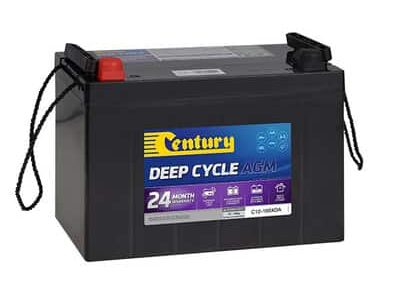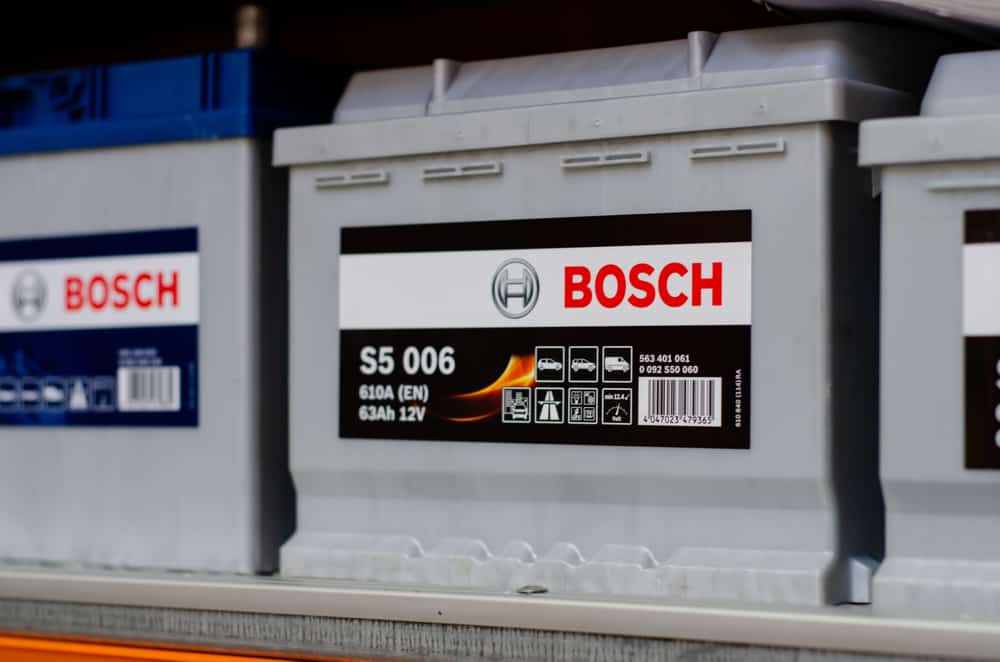An AGM (absorbent glass mat) battery (also known as a VRLA battery) uses a glass mat separator to wick its electrolyte solution between the battery plates. This saturates the fiberglass with the electrolyte but still allows for “dry” storage that opposes the free liquid in flooded batteries.
When the battery is used, the electrolyte transfers from the mat to the plates to ensure the battery remains fully capable. While this maintenance-free design prevents leaking or spilling from damage or tipping, these batteries are particularly sensitive to over and undercharging.
Understanding the intricacies of AGM battery charging is incredibly important to preserve battery life and protect your investment.
Table of Contents
AGM vs Deep Cycle vs Traditional Lithium Battery Charging
Most people are more familiar with Lithium batteries than they are lead acid batteries, and they may have been spoiled by a simpler charging process.
Lithium batteries, like those found in your laptops and cell phones, will not be damaged if you only charge them part of the way. Lithium batteries can discharge anywhere from 90 to 95 percent, whereas AGM batteries shouldn’t drop below 80 percent depth of discharge.
While lithium batteries are considered more efficient and have a simpler charging process, they’re usually twice as much as a comparable AGM battery.
Many prefer AGM batteries because they are cheaper but still offer a spill-proof chassis. While an older lead-acid deep cycle battery can tolerate overcharging better than an AGM battery, these batteries cover a decent middle ground for convenience and value.
Learning how to charge your AGM battery the right way can save you money to start and prevent you from premature losses down the line.
3 Stages of AGM Battery Charging
An AGM battery follows a three stage charging process. The steps include:
- Constant Current (Bulk): max current and constant voltage
- Constant Voltage (Absorption): voltage decreases
- Supplemental (Float): after full charge; voltage reduced; prevents self-discharge of the battery
Each part of this CCCV process is important for the whole battery health.
Stage 1: Constant Current Charge (Bulk)
When you bulk charge, you set your charger to the cycle charge voltage and current listed by your battery. Setting it too high will overcharge the battery and cause damage, but undercharging may interfere with its ability to fully recharge in the future.
Stage 2: Constant Voltage Charge (Absorption)
During the absorption phase, the battery voltage holds steady while the current decreases. It keeps dropping until reaching a lower value, handing off the baton for float charging.
The constant voltage charge tops off the battery.
Stage 3: Supplemental Charge (Float)
The float stage features a shallow current and trickle charges the battery. This keeps the battery’s materials active and compensates for any loss from self-discharge, ensuring good health and upholding the battery’s typical lifespan.
AGM Battery Charging Basics

While smart chargers consider all variables to protect your battery, understanding the demands of each stage empowers you to protect your battery and use other chargers when needed.
These details include:
- Charge voltage
- Charge current
- Battery capability
- Battery alignment
In many cases, these variables are freely provided on the battery label or manufacturer. If not, there are some general numbers you can get by with little to no damage to your AGM battery.
Charge Voltage
The voltage differs depending on which stage you are in. Bulk charging needs a higher voltage to power through, but this decreases considerably by the time you reach the trickle charge stage.
The highest charge voltage you may use is when fast charging your batteries, but this should only occur under emergency conditions.
The nominal voltage of a single cell in your AGM battery is 2V. Cells can be combined to create different battery voltages (the most common being 6V, 12V, 24V, and 48V). Assuming proper temperature conditions, you can use a predetermined charge voltage for your battery bank.
| AGM Battery Voltage | CC Voltage | Supplemental Voltage |
| 2V | 2.40V to 2.50V | 2.25V to 2.30V |
| 6V | 7.20V to 7.50V | 6.75V to 6.90V |
| 12V | 14.4V to 15.0V | 13.5V to 13.8V |
| 24V | 28.8V to 30.0V | 27.0V to 27.6V |
| 48V | 57.6V to 60.0V | 54.0V to 55.2V |
If a battery lists the charge voltage on its label, best practice is to err on the lower portion of the range. This decreases any chance for overcharging and damaging your battery.
Temperature Compensation
It’s important to note that charge voltage may change depending on the temperature while you charge your batteries.
In lower temperatures, the flow of electrons slows and you may need to increase the voltage to compensate for this. The opposite is true in higher temperatures when electrons flow more freely and overcharging is more likely.
These are the generally accepted formulas when compensating for temperature:
- Cycle voltage: -30mV/°C
- Float voltage: -20mV/°C
Only charge your AGM batteries when the temperature is between 0° and 40°C (32° to 104°F). Charging outside of these temperatures is likely to damage your batteries.
Estimating Using Open-Circuit Voltage (OCV)
Another way to estimate the charge cycle voltage uses the OCV of the battery when it’s fully charged. In most cases, the OCV of a 12 volt battery plus 1 to 1.5V should be sufficient for charge voltage.
To calculate this number, use a DC voltmeter to measure the voltage of the battery that remains over an hour after it is fully charged.
If you’re going in blind, using 2.4V per cell of the battery may suffice, but it requires close monitoring. You’re at a greater risk for overcharging, so we recommend sticking it out until you find the actual value from the manufacturer’s operating instruction
Charge Current and Battery Capacity
The needed charge current relates to the capacity of your battery. The current is usually between 0.1C and 0.4C (1/10 to 4/10 of the rated capacity). We measure current in amperes (A), and capacity in amp hours (Ah).
‘If the capacity is not listed on your print label, you may need to consult your paperwork or reach out to the manufacturer for this information. Sometimes capacity is listed in wattage, in which case you divide the number by 4 to find the charge current.
If you have an AGM battery with a capacity of 100 Ah, the charge current would be between 10A and 40A (10 to 40 percent of the capacity).
Some advanced manufacturers use thin plate technology, although it is not as common. These batteries instruct you to use a charging current of 1C, meaning it equals the rated capacity.
Charging Connection
Connecting a single AGM battery to a charge is simple. Connect the appropriately charged poles of the battery charger to their corresponding battery terminals (positive to positive then negative to negative).
When charging multiple batteries, most recommend a parallel connection. This lets you keep the voltage low, and keeps battery performance consistent.
When charging in a series, you must increase the voltage of your charger. Charging in a parallel takes longer because it increases the capacity, but it maintains the original voltage and is safer overall.
AGM Battery Charging Time and Other Considerations
In most cases, the charging time of an AGM battery is equal to 1.2 times the required amount of power.
If we’re charging a 100 Ah AGM battery that has been fully discharged, you will need to charge it to 120 Ah for it to be full. When you divide that by the charging current (.15C/15A) you find that it will take about 8 hours to get close to a full charge.
Keep in mind that you shouldn’t be charging a completely depleted deep cycle battery, and charging time differs depending on your current depth of depletion and charge current.
Regardless of what battery chargers you use (smart or not), you should monitor your battery while charging. Certain details, such as temperature and the noise your battery makes, can warn you of major issues before they cause irreversible damage.
Excessive Heat
A battery will be warm while charging, but it should be burning hot. If you notice unusually high temperatures, you should stop charging the battery completely.
You can try again later, ideally with a reduced charging voltage or current (or both), but you should discontinue charging if the issue persists.
Sound
A bubbling sound is normal when charging your AGM battery. The battery cells release heat energy as the current passes through the electrolyte solution, and water particles will break down into gas bubbles such as H2 and O2.
Excessive bubbling is often indicative of overheating. If you notice this or a hissing noise, you need to lower the voltage or current (or both) or discontinue charging while the issue subsides.
Overcharging/ Undercharging
Overcharging usually happens if you use a voltage or current higher than the maximum recommendation, but it can also occur if you do not pay attention to the issues listed above.
When an AGM battery overcharges it leads to grid corrosion that reduces battery life. Eventually, the plates in the cells will buckle and shed the active material needed for normal operation.
Undercharging occurs with a lower-than-recommended voltage or current, and it leads to battery sulfation. When this happens, lead sulfate forms on the negative plates of your valve-regulated battery’s negative plates and terminals, reducing their surface area and interfering with future charge.
This battery type may require less maintenance than other batteries, but proper charging is highly critical.
Conclusion
Whether your AGM battery is a starting battery for your automobile, an energy bank for your solar panels, or anything in between, you want to ensure the power is there when you need it the most. Proper charging is essential for these batteries.
Remember to:
- Follow proper charging procedures, either with a smart charger or careful monitoring
- Use a trickle charger in off months to prevent deep depletion
- Replace the battery when the battery is no longer healthy
If you still need help getting the hang of charging AGM batteries, drop a comment below!
